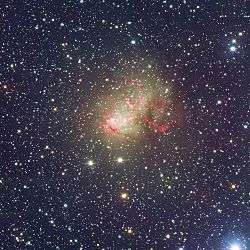IC 10
IC 10 is an irregular galaxy in the constellation Cassiopeia. It was discovered by Lewis Swift in 1887[4] and in 1935 Nicholas Mayall became the first to suggest that the object is extragalactic. Edwin Hubble suspected it might belong to the Local Group of galaxies, but its status remained uncertain for decades. The radial velocity of IC 10 was measured in 1962, and it was found to be approaching the Milky Way at approximately 350 km/s, strengthening the evidence for its membership in the Local Group.[4] Its membership in the group was finally confirmed in 1996 by direct measurements of its distance based on observations of Cepheids. Despite its closeness, the galaxy is rather difficult to study because it lies near the plane of the Milky Way and is therefore heavily obscured by interstellar matter.[5]
| IC 10 | |
|---|---|
 Irregular Galaxy IC 10. | |
| Observation data (J2000 epoch) | |
| Constellation | Cassiopeia |
| Right ascension | 00h 20m 17.3s[1] |
| Declination | +59° 18′ 14″[1] |
| Redshift | -0.001161 +/- 0.000003[1] |
| Distance | 2.2 ± 0.2 Mly (660 ± 60 kpc)[2] |
| Apparent magnitude (V) | 10.4 ± 0.2 [3] |
| Characteristics | |
| Type | dIrr IV/BCD[1] |
| Apparent size (V) | 6′.8 × 5′.9[1] |
| Notable features | mild starburst galaxy |
| Other designations | |
| UGC 192,[1] PGC 1305[1] | |
The apparent distance between IC 10 and the Andromeda Galaxy is about the same as the apparent distance between the Andromeda Galaxy and the Triangulum Galaxy, which suggests that IC 10 may belong to the M31 subgroup.[5]
IC 10 is the only known starburst galaxy in the Local Group of galaxies. It has many more Wolf–Rayet stars per square kiloparsec (5.1 stars/kpc2) than the Large Magellanic Cloud (2.0 stars/kpc2) or the Small Magellanic Cloud (0.9 stars/kpc2). Although the galaxy has a luminosity similar to the SMC, it is considerably smaller. Its higher metallicity compared to the SMC suggests that star formation activity has continued for a longer time period. The evolutionary status of the Wolf–Rayet stars suggests that they all formed in a relatively short timespan. The ratio between the two types of Wolf–Rayet stars (WC stars and WN stars) in IC 10 is very different from the ratio in other galaxies in the Local Group, which may be somehow due to the starburst nature of the galaxy. Currently, the galaxy produces stars at the rate of 0.04–0.08 solar masses per year, which means that the gas supply in the galaxy can last for only a few billion years longer.[5]
Observations of IC 10 in the far-infrared show that the dust in this mild starburst galaxy is deficient in small grains.[6] It is hypothesized that any small grains that formerly existed were destroyed by strong ultraviolet radiation in the areas around the hot luminous stars that were formed in the galaxy's recent burst of star formation.[7]
The galaxy has a huge envelope of hydrogen gas, with an apparent size measuring 68′ × 80′, which is far larger than the apparent size of the galaxy in visible light (5.5′ × 7.0′). IC 10 is also unusual in the respect that the visible part of the galaxy seems to rotate in a different direction than the outer envelope.[5] It has a H II nucleus.[8]
Gallery
References
- "NASA/IPAC Extragalactic Database". Results for IC 10. Retrieved 15 March 2007.
- Karachentsev, I. D.; Kashibadze, O. G. (2006). "Masses of the local group and of the M81 group estimated from distortions in the local velocity field". Astrophysics. 49 (1): 3–18. Bibcode:2006Ap.....49....3K. doi:10.1007/s10511-006-0002-6.
- "IC 10". Star-Watcher.
- "IC 10". SEDS Messier Database. Retrieved 15 May 2006.
- Van den Bergh, Sidney (2000). Galaxies of the Local Group (1st ed.). Cambridge University Press. ISBN 0-521-65181-6.
- Bolatto, A. D.; Jackson, J. M.; Wilson, C. D.; Moriarty-Schieven, G. (2000). "Submillimeter Observations of IC 10: The Dust Properties and Neutral Carbon Content of a Low-Metallicity Starburst". Astrophysical Journal. 532 (2): 909–921. arXiv:astro-ph/9910564. Bibcode:2000ApJ...532..909B. doi:10.1086/308590.
- van den Bergh, Sidney (April 2000). "Updated Information on the Local Group". The Publications of the Astronomical Society of the Pacific. 112 (770): 529–536. arXiv:astro-ph/0001040. Bibcode:2000PASP..112..529V. doi:10.1086/316548.
- Ho, Luis C.; Filippenko, Alexei V.; Sargent, Wallace L. W. (October 1997). "A Search for 'Dwarf' Seyfert Nuclei. III. Spectroscopic Parameters and Properties of the Host Galaxies". Astrophysical Journal Supplement. 112. p. 315. arXiv:astro-ph/9704107. Bibcode:1997ApJS..112..315H. doi:10.1086/313041.
- "Spiral, elliptical, irregular". www.spacetelescope.org. Retrieved 17 June 2019.
External links
| Wikimedia Commons has media related to IC 10. |
- Irregular Galaxy IC 10 @ SEDS IC objects pages
- IC 10 imaged through a semi-professional amateur-telescope
